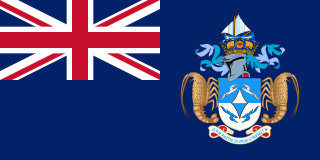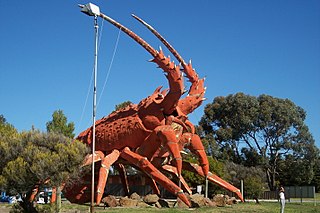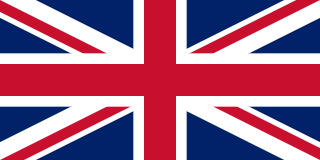
Tristan da Cunha, colloquially Tristan, is a remote group of volcanic islands in the South Atlantic Ocean. It is one of three constituent parts of the British Overseas Territory of Saint Helena, Ascension and Tristan da Cunha, with its own constitution.
Tristan da Cunha is part of the British overseas territory of Saint Helena, Ascension and Tristan da Cunha and has a history going back to the beginning of the 16th century. It was settled by men from military garrisons and ships, who married native women from Saint Helena and the Cape Colony. Its people are multi-racial, descended from European male founders and mixed-race and African women founders.

The rockhopper penguins are three closely related taxa of crested penguins that have been traditionally treated as a single species and are sometimes split into three species.

Gough Island, also known historically as Gonçalo Álvares, is a rugged volcanic island in the South Atlantic Ocean. It is a dependency of Tristan da Cunha and part of the British overseas territory of Saint Helena, Ascension and Tristan da Cunha. It is approximately 400 km (250 mi) south-east of the Tristan da Cunha archipelago, 2,400 km (1,500 mi) north-east from South Georgia Island, 2,700 km (1,700 mi) west from Cape Town, and over 3,200 km (2,000 mi) from the nearest point of South America.

Inaccessible Island is a volcanic island located in the South Atlantic Ocean, 31 km (19 mi) south-west of Tristan da Cunha. Its highest point, Swale's Fell, reaches 581 m (1,906 ft), and the island is 12.65 km2 (4.88 sq mi) in area. The volcano was last active approximately one million years ago and is now extinct.

Nightingale Island is an active volcanic island in the South Atlantic Ocean, 3 square kilometres (1.2 sq mi) in area, part of the Tristan da Cunha group of islands. They are administered by the United Kingdom as part of the overseas territory of Saint Helena, Ascension and Tristan da Cunha.

Kingston SE, formerly Kingston, is a town in the Australian state of South Australia located in the state's south-east coastline on the shores of Lacepede Bay. It is located about 240 kilometres southeast of the state capital of Adelaide and 138 kilometres north-west of the centre of the city of Mount Gambier.

Edinburgh of the Seven Seas is the only settlement on the island of Tristan da Cunha, a part of the British Overseas Territory of Saint Helena, Ascension and Tristan da Cunha in the South Atlantic Ocean. Locally, it is referred to as The Settlement or The Village.

The Nightingale Islands are a group of three islands in the South Atlantic Ocean, part of the Tristan da Cunha territory. They consist of Nightingale Island, Middle Island and Stoltenhoff Island. The islands are administered by the United Kingdom as part of the overseas territory of Saint Helena, Ascension and Tristan da Cunha. The Nightingale Islands are uninhabited.
MS Berge Vanga was an ore-bulk-oil carrier with 227,912 tonnes deadweight (DWT). The ship was owned by Norwegian shipping company Sig. Bergesen d.y. and registered in Liberia. The ship had build number 300 at the Uljanik shipyard in the port city Pula in then SFR Yugoslavia where it was built in 1974.

The Tristan thrush, also known as the starchy, is a species of bird in the thrush family that is endemic to the British overseas territories of the isolated Tristan da Cunha archipelago in the South Atlantic Ocean.

Wilkins's Bunting , also known as the grosbeak bunting, is a species of bird in the family Thraupidae. It is restricted to Inaccessible Island and Nightingale Island of the Tristan da Cunha archipelago, part of the British overseas territory of Saint Helena in the South Atlantic Ocean. Its natural habitats are temperate shrubland and subantarctic grassland.

The following outline is provided as an overview of and topical guide to Tristan da Cunha:

The northern rockhopper penguin, Moseley's rockhopper penguin, or Moseley's penguin is a penguin species native to the southern Indian and Atlantic Oceans. It is described as distinct from the southern rockhopper penguin.

København (Copenhagen) was a Danish owned, British-built five-masted barque used as a naval training vessel until its disappearance after 22 December 1928. Built for the Danish East Asiatic Company in 1921, it was the world's largest sailing ship at the time, and primarily served for sail training of young cadets.

Saint Helena, Ascension and Tristan da Cunha is a British Overseas Territory located in the South Atlantic and consisting of the island of Saint Helena, Ascension Island, and the archipelago of Tristan da Cunha. Its name was Saint Helena and Dependencies until 1 September 2009, when a new constitution came into force, giving the three islands equal status as three territories, with a grouping under the Crown.

Tristan da Cunha is an archipelago of five islands in the southern Atlantic Ocean, the largest of which is the island of Tristan da Cunha itself and the second-largest, the remote bird haven, Gough Island. It forms part of a wider territory called Saint Helena, Ascension and Tristan da Cunha which includes Saint Helena and Ascension Island.
The year 2011 in birding and ornithology.

DryShips Inc is a dry bulk shipping company based in Athens, Greece. It is a Marshall Islands corporation, formed in 2004. On October 11, 2019, it was taken private by CEO and Chairman George Economou.

Sandy Point is the easternmost extremity of the island of Tristan da Cunha in the South Atlantic Ocean. It is a distance of about 7 miles (12 km) by sea from the island's only settlement, Edinburgh of the Seven Seas. There is a beach of black volcanic sand fringed by low cliffs and a sloping plateau leading up to Tristan's mountainous interior. Its climate is warmer and drier than that of the Settlement, being in the lee of the island's prevailing winds.













